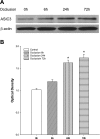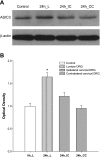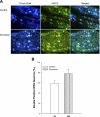Femoral artery occlusion increases expression of ASIC3 in dorsal root ganglion neurons
- PMID: 20852050
- PMCID: PMC2993190
- DOI: 10.1152/ajpheart.00612.2010
Femoral artery occlusion increases expression of ASIC3 in dorsal root ganglion neurons
Abstract
Acid-sensing ion channels (ASICs) in sensory nerves are responsive to increases in the levels of protons in the extracellular medium. Prior studies suggest that the muscle metabolite, lactic acid, plays a role in reflex sympathetic and cardiovascular responses via stimulation of thin muscle afferent nerves. Also, femoral artery occlusion augments the reflex sympathetic nerve response in rats. ASIC3 is a main subtype to appear in sensory nerves in mediating the response induced by increases in protons in the interstitial space of contracting muscles. Thus, in this article, we hypothesized that femoral occlusion increases the expression of ASIC3 in primary afferent neurons innervating muscles, and this contributes to the exaggerated reflex sympathetic responses. Femoral occlusion/vascular insufficiency of the hindlimb muscles was induced by the femoral artery ligation in rats. First, Western blot analysis shows that 24-72 h of femoral artery ligation significantly increased the expression of ASIC3 protein in dorsal root ganglion (optical density, 1.0 ± 0.07 in control vs. 1.65 ± 0.1 after 24 h of occlusion, P < 0.05; n = 6 in each group). There were no significant differences for increases in ASIC3 24 and 72 h postocclusion. Second, experiments using fluorescent immunohistochemistry and retrograde-labeling technique show that a greater percentage of ASIC3 staining neurons are localized in muscle-innervating dorsal root ganglion neurons after the arterial occlusion (78 ± 3% in 24 h post occlusion vs. 59 ± 5% in control, P < 0.05; n = 6 in each group). Third, the reflex responses in renal sympathetic nerve and arterial blood pressure induced by the stimulation of ASIC were examined after an injection of lactic acid into the arterial blood supply of hindlimb muscles of control rats and ligated rats. The results demonstrate that the sympathetic and pressor responses to lactic acid were significantly augmented after femoral occlusion compared with those in the control group. The data of this study suggest that enhanced ASIC3 expression in muscle afferent nerves contributes to the exaggerated reflex sympathetic and pressor responses to lactic acid as seen in arterial occlusion.
Figures




Similar articles
-
Role for NGF in augmented sympathetic nerve response to activation of mechanically and metabolically sensitive muscle afferents in rats with femoral artery occlusion.J Appl Physiol (1985). 2012 Oct 15;113(8):1311-22. doi: 10.1152/japplphysiol.00617.2012. Epub 2012 Jun 28. J Appl Physiol (1985). 2012. PMID: 22744968 Free PMC article.
-
Contribution of nerve growth factor to upregulation of P2X₃ expression in DRG neurons of rats with femoral artery occlusion.Am J Physiol Heart Circ Physiol. 2011 Sep;301(3):H1070-9. doi: 10.1152/ajpheart.00188.2011. Epub 2011 Jun 3. Am J Physiol Heart Circ Physiol. 2011. PMID: 21642505 Free PMC article.
-
Acid-sensing ion channel subtype 3 function and immunolabelling increases in skeletal muscle sensory neurons following femoral artery occlusion.J Physiol. 2012 Mar 1;590(5):1261-72. doi: 10.1113/jphysiol.2011.221788. Epub 2011 Dec 19. J Physiol. 2012. PMID: 22183722 Free PMC article.
-
ASIC3: a lactic acid sensor for cardiac pain.ScientificWorldJournal. 2001 Oct 5;1:510-2. doi: 10.1100/tsw.2001.254. ScientificWorldJournal. 2001. PMID: 12805843 Free PMC article. Review.
-
Sympathetic Nerve Activity and Blood Pressure Response to Exercise in Peripheral Artery Disease: From Molecular Mechanisms, Human Studies, to Intervention Strategy Development.Int J Mol Sci. 2022 Sep 13;23(18):10622. doi: 10.3390/ijms231810622. Int J Mol Sci. 2022. PMID: 36142521 Free PMC article. Review.
Cited by
-
ASIC1a plays a key role in evoking the metabolic component of the exercise pressor reflex in rats.Am J Physiol Heart Circ Physiol. 2020 Jan 1;318(1):H78-H89. doi: 10.1152/ajpheart.00565.2019. Epub 2019 Nov 1. Am J Physiol Heart Circ Physiol. 2020. PMID: 31675256 Free PMC article.
-
Role of TNF-α in Regulating the Exercise Pressor Reflex in Rats With Femoral Artery Occlusion.Front Physiol. 2018 Oct 15;9:1461. doi: 10.3389/fphys.2018.01461. eCollection 2018. Front Physiol. 2018. PMID: 30374312 Free PMC article.
-
Functional knockout of ASIC3 attenuates the exercise pressor reflex in decerebrated rats with ligated femoral arteries.Am J Physiol Heart Circ Physiol. 2020 May 1;318(5):H1316-H1324. doi: 10.1152/ajpheart.00137.2020. Epub 2020 Apr 17. Am J Physiol Heart Circ Physiol. 2020. PMID: 32302492 Free PMC article.
-
Heart failure induces changes in acid-sensing ion channels in sensory neurons innervating skeletal muscle.J Physiol. 2015 Oct 15;593(20):4575-87. doi: 10.1113/JP270690. Epub 2015 Sep 23. J Physiol. 2015. PMID: 26314284 Free PMC article.
-
Dual Modulation of Nociception and Cardiovascular Reflexes during Peripheral Ischemia through P2Y1 Receptor-Dependent Sensitization of Muscle Afferents.J Neurosci. 2016 Jan 6;36(1):19-30. doi: 10.1523/JNEUROSCI.2856-15.2016. J Neurosci. 2016. PMID: 26740646 Free PMC article.
References
-
- Aslam F, Haque A, Foody J, Lee LV. Peripheral arterial disease: current perspectives and new trends in management. South Med J 102: 1141–1149, 2009 - PubMed
-
- Baccelli G, Reggiani P, Mattioli A, Corbellini E, Garducci S, Catalano M. The exercise pressor reflex and changes in radial arterial pressure and heart rate during walking in patients with arteriosclerosis obliterans. Angiology 50: 361–374, 1999 - PubMed
-
- Bakke EF, Hisdal J, Jorgensen JJ, Kroese A, Stranden E. Blood pressure in patients with intermittent claudication increases continuously during walking. Eur J Vasc Endovasc Surg 33: 20–25, 2007 - PubMed
-
- Cho HJ, Staikopoulos V, Furness JB, Jennings EA. Inflammation-induced increase in hyperpolarization-activated, cyclic nucleotide-gated channel protein in trigeminal ganglion neurons and the effect of buprenorphine. Neuroscience 162: 453–461, 2009 - PubMed
Publication types
MeSH terms
Substances
Grants and funding
LinkOut - more resources
Full Text Sources

